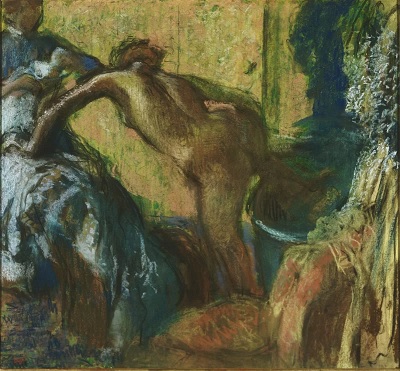
from Amazon
* As an Amazon Associate, and partner with Google Adsense and Ezoic, I earn from qualifying purchases.
Contributing artist of the impressionist era, Edgar Degas, showcases a melodic array of movement within his work through the element of colour.
At the onset of the artist’s career, he began depicting pastel renditions of different events that seized his mind. Degas is famously known for depicting the female presence within his artwork, as their mystical emotion and attributes seized the medium of his work. At the onset of his career, Degas began showcasing pastel on paper illustrations of nude women and young women dancing ballet. Some of the artist’s earliest works include Group of Dancers, Blue Dancers, At the Races and Bellelli Family. The style of the artwork is parallel to the provoking artwork created by the French artist Pierre-Auguste Renoir.
After The Bath belongs to a long collection of pastel drawings by Degas. The certain portrait showcases a nude woman kneeling on a couch as she dries her hair. The woman is gently hunched over as she softens her wet dripping hair. The pastel piece holds an intriguing element behind the artwork as her nude form captivates viewers. Her lack of knowledge towards what is occurring adds a mysterious touch to the artwork, or rather her dismissal of the viewer adds even more depth within the piece. Degas showcases her tender body as he uses an array of shades to illuminate and contour her skin. A warm colour palette is used as shades of red, orange, and peach fill her skin in a linear stroke. The artist adds a shade of green near the shoulders of the woman in order to add a contrast to her form, alongside connect her body to the background wall.
As the artwork belongs to one of Degas’s founding pieces of pastel on paper portraits, his fresh ability is showcased through the awkward leg placement of the woman. Her legs seems to neither be bent nor straight, creating a deformed attribute. It is most likely the artist’s lack of experience that led him to showcase the limb in the complex position. Yet, the artist highlights this area, alongside the tip of the woman’s shoulder in order to create a light source. While the pastel on paper art piece is one of the first works by Degas, his gifted ability fathomed to place a light source in order to create depth and form within the work.
Degas colours the couch in a lilac lavender shade. The colour is changed to a white shade upon where it comes into contact with the light. Near the bottom left of the painting, an orange shade merges with reds and purples in a blur of colour that bleeds into the background. A similar technique is used as Degas mixes shades of orange and green as one near the background of the artwork. It seems as if a corner is showcased at the top left portion of the piece, advancing Degas’s use of depth. The artist does not spend time showcasing the facial features of the woman, as a deep hue of burnt red covers her face. It is evident that the artist exposes the woman’s hair through a rich brown colour that swirls on the top of her head into a bun. Degas does not illuminate the woman’s face, yet rather hides her expression behind the deep hues of her hair.
The darkest colours throughout the painting are located near the woman’s head, hiding the area from being a focal point of the painting. Instead the hips of the woman and her bare shoulders are illuminated in a lighter tone to accentuate characteristics. The lilac lavender colour of the couch emerges from beneath the woman adding a happier emotion to the painting. The viewers are left to ponder the beautiful environment of the painting, alongside the coveted muse.